|
|
|
Wood characteristics? |
Post Reply 
|
| Author | ||||||||||||||||||||||||||||||||||||||||||||||||||||||||||||||||||||||||||||||||||||||||||||||||||||||||||||||||||||||||||||||||||||||||||||||||||||||||
apflor323 
Super Member 
Joined: 11/02/2008 Location: United States Status: Offline Points: 345 |
 Post Options Post Options
 Thanks(0) Thanks(0)
 Quote Quote  Reply Reply
 Topic: Wood characteristics? Topic: Wood characteristics?Posted: 06/06/2009 at 6:38pm |
|||||||||||||||||||||||||||||||||||||||||||||||||||||||||||||||||||||||||||||||||||||||||||||||||||||||||||||||||||||||||||||||||||||||||||||||||||||||
|
Here is an interesting topic.... What is the effect of the type of wood used on a blade? For now, let's try to exclude composite blades....
|
||||||||||||||||||||||||||||||||||||||||||||||||||||||||||||||||||||||||||||||||||||||||||||||||||||||||||||||||||||||||||||||||||||||||||||||||||||||||
|
T05/Treiber Z/Rasant Powersponge
FEEDBACK HERE |
||||||||||||||||||||||||||||||||||||||||||||||||||||||||||||||||||||||||||||||||||||||||||||||||||||||||||||||||||||||||||||||||||||||||||||||||||||||||
 |
||||||||||||||||||||||||||||||||||||||||||||||||||||||||||||||||||||||||||||||||||||||||||||||||||||||||||||||||||||||||||||||||||||||||||||||||||||||||
| Sponsored Links | ||||||||||||||||||||||||||||||||||||||||||||||||||||||||||||||||||||||||||||||||||||||||||||||||||||||||||||||||||||||||||||||||||||||||||||||||||||||||
 |
||||||||||||||||||||||||||||||||||||||||||||||||||||||||||||||||||||||||||||||||||||||||||||||||||||||||||||||||||||||||||||||||||||||||||||||||||||||||
JRSDallas 
Silver Member 
Joined: 09/03/2005 Location: USA Status: Offline Points: 585 |
 Post Options Post Options
 Thanks(0) Thanks(0)
 Quote Quote  Reply Reply
 Posted: 06/06/2009 at 6:59pm Posted: 06/06/2009 at 6:59pm |
|||||||||||||||||||||||||||||||||||||||||||||||||||||||||||||||||||||||||||||||||||||||||||||||||||||||||||||||||||||||||||||||||||||||||||||||||||||||
|
See this thread for an actual explaination: |
||||||||||||||||||||||||||||||||||||||||||||||||||||||||||||||||||||||||||||||||||||||||||||||||||||||||||||||||||||||||||||||||||||||||||||||||||||||||
 |
||||||||||||||||||||||||||||||||||||||||||||||||||||||||||||||||||||||||||||||||||||||||||||||||||||||||||||||||||||||||||||||||||||||||||||||||||||||||
ianworz 
Super Member 

Joined: 04/01/2009 Location: United States Status: Offline Points: 476 |
 Post Options Post Options
 Thanks(0) Thanks(0)
 Quote Quote  Reply Reply
 Posted: 06/06/2009 at 7:02pm Posted: 06/06/2009 at 7:02pm |
|||||||||||||||||||||||||||||||||||||||||||||||||||||||||||||||||||||||||||||||||||||||||||||||||||||||||||||||||||||||||||||||||||||||||||||||||||||||
|
softness/hardness (= stiffness/flexibility, speed, spin [much less influence than rubber], weight, dwell time (how long the ball sits on the blade during impact), feedback (the wood's vibration and feel)
For example, a blade made of willow (low bounce, 360 (or so) hardness on the janka scale, would absorb the shock of an incoming ball, thus slowing it down, also because the wood is soft and has a lower bounce rate, it's dwell time would be greater, thus creating more spin. A blade with outter plies of Ipe (the hardest wood in the world) would feel stiffer and have little dwell time, but more speed. |
||||||||||||||||||||||||||||||||||||||||||||||||||||||||||||||||||||||||||||||||||||||||||||||||||||||||||||||||||||||||||||||||||||||||||||||||||||||||
 |
||||||||||||||||||||||||||||||||||||||||||||||||||||||||||||||||||||||||||||||||||||||||||||||||||||||||||||||||||||||||||||||||||||||||||||||||||||||||
Piri 
Super Member 
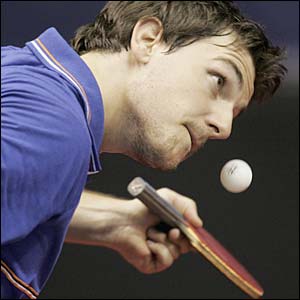
Joined: 07/06/2008 Location: Dominican Republic Status: Offline Points: 439 |
 Post Options Post Options
 Thanks(0) Thanks(0)
 Quote Quote  Reply Reply
 Posted: 06/06/2009 at 7:21pm Posted: 06/06/2009 at 7:21pm |
|||||||||||||||||||||||||||||||||||||||||||||||||||||||||||||||||||||||||||||||||||||||||||||||||||||||||||||||||||||||||||||||||||||||||||||||||||||||
|
This might help as well http://butterflyonline.com/shakehand_blade.asp#
|
||||||||||||||||||||||||||||||||||||||||||||||||||||||||||||||||||||||||||||||||||||||||||||||||||||||||||||||||||||||||||||||||||||||||||||||||||||||||
|
Nittaku Acoustic St.
FH: BTY Tenergy 05 2.1 BH: BTY Tenergy 64 2.1 |
||||||||||||||||||||||||||||||||||||||||||||||||||||||||||||||||||||||||||||||||||||||||||||||||||||||||||||||||||||||||||||||||||||||||||||||||||||||||
 |
||||||||||||||||||||||||||||||||||||||||||||||||||||||||||||||||||||||||||||||||||||||||||||||||||||||||||||||||||||||||||||||||||||||||||||||||||||||||
ianworz 
Super Member 

Joined: 04/01/2009 Location: United States Status: Offline Points: 476 |
 Post Options Post Options
 Thanks(0) Thanks(0)
 Quote Quote  Reply Reply
 Posted: 06/06/2009 at 7:23pm Posted: 06/06/2009 at 7:23pm |
|||||||||||||||||||||||||||||||||||||||||||||||||||||||||||||||||||||||||||||||||||||||||||||||||||||||||||||||||||||||||||||||||||||||||||||||||||||||
You bastard genius. Good work. |
||||||||||||||||||||||||||||||||||||||||||||||||||||||||||||||||||||||||||||||||||||||||||||||||||||||||||||||||||||||||||||||||||||||||||||||||||||||||
 |
||||||||||||||||||||||||||||||||||||||||||||||||||||||||||||||||||||||||||||||||||||||||||||||||||||||||||||||||||||||||||||||||||||||||||||||||||||||||
bearT 
Beginner 
Joined: 02/15/2009 Location: United States Status: Offline Points: 71 |
 Post Options Post Options
 Thanks(0) Thanks(0)
 Quote Quote  Reply Reply
 Posted: 06/06/2009 at 10:18pm Posted: 06/06/2009 at 10:18pm |
|||||||||||||||||||||||||||||||||||||||||||||||||||||||||||||||||||||||||||||||||||||||||||||||||||||||||||||||||||||||||||||||||||||||||||||||||||||||
 |
||||||||||||||||||||||||||||||||||||||||||||||||||||||||||||||||||||||||||||||||||||||||||||||||||||||||||||||||||||||||||||||||||||||||||||||||||||||||
apflor323 
Super Member 
Joined: 11/02/2008 Location: United States Status: Offline Points: 345 |
 Post Options Post Options
 Thanks(0) Thanks(0)
 Quote Quote  Reply Reply
 Posted: 06/07/2009 at 1:03am Posted: 06/07/2009 at 1:03am |
|||||||||||||||||||||||||||||||||||||||||||||||||||||||||||||||||||||||||||||||||||||||||||||||||||||||||||||||||||||||||||||||||||||||||||||||||||||||
|
JSRDallas.....
Are you still human or some kind of table tennis manufacturing machine?
Thanks for the info!
|
||||||||||||||||||||||||||||||||||||||||||||||||||||||||||||||||||||||||||||||||||||||||||||||||||||||||||||||||||||||||||||||||||||||||||||||||||||||||
|
T05/Treiber Z/Rasant Powersponge
FEEDBACK HERE |
||||||||||||||||||||||||||||||||||||||||||||||||||||||||||||||||||||||||||||||||||||||||||||||||||||||||||||||||||||||||||||||||||||||||||||||||||||||||
 |
||||||||||||||||||||||||||||||||||||||||||||||||||||||||||||||||||||||||||||||||||||||||||||||||||||||||||||||||||||||||||||||||||||||||||||||||||||||||
firetack 
Silver Member 
Joined: 10/18/2006 Location: England Status: Offline Points: 950 |
 Post Options Post Options
 Thanks(0) Thanks(0)
 Quote Quote  Reply Reply
 Posted: 06/07/2009 at 4:22am Posted: 06/07/2009 at 4:22am |
|||||||||||||||||||||||||||||||||||||||||||||||||||||||||||||||||||||||||||||||||||||||||||||||||||||||||||||||||||||||||||||||||||||||||||||||||||||||
|
[QUOTE=ianworz]softness/hardness (= stiffness/flexibility, speed, spin [much less influence than rubber], weight, dwell time (how long the ball sits on the blade during impact), feedback (the wood's vibration and feel)
For example, a blade made of willow (low bounce, 360 (or so) hardness on the janka scale, would absorb the shock of an incoming ball, thus slowing it down, also because the wood is soft and has a lower bounce rate, it's dwell time would be greater, thus creating more spin. i can create more backspin with willow than any other wood,the chops spin back under the table if they go long and land on the floor,but the topspin making with this wood was not so good,i found the dwell time too high making the topspins too flat,this was def alpha blade,my ideal blade would have willow on backhand and koto outer ply to f/h
|
||||||||||||||||||||||||||||||||||||||||||||||||||||||||||||||||||||||||||||||||||||||||||||||||||||||||||||||||||||||||||||||||||||||||||||||||||||||||
|
Black Balsa 3.0 fh/tenergy 05 1.9 388d ox
|
||||||||||||||||||||||||||||||||||||||||||||||||||||||||||||||||||||||||||||||||||||||||||||||||||||||||||||||||||||||||||||||||||||||||||||||||||||||||
 |
||||||||||||||||||||||||||||||||||||||||||||||||||||||||||||||||||||||||||||||||||||||||||||||||||||||||||||||||||||||||||||||||||||||||||||||||||||||||
JRSDallas 
Silver Member 
Joined: 09/03/2005 Location: USA Status: Offline Points: 585 |
 Post Options Post Options
 Thanks(0) Thanks(0)
 Quote Quote  Reply Reply
 Posted: 06/07/2009 at 6:45am Posted: 06/07/2009 at 6:45am |
|||||||||||||||||||||||||||||||||||||||||||||||||||||||||||||||||||||||||||||||||||||||||||||||||||||||||||||||||||||||||||||||||||||||||||||||||||||||
|
Since the time of that series of posts I provided a link for, I've also mearured the frequency modes of more than 25 different blades and modeling.
As the earlier thread explains, blades vibrate when struck in a series of increasingly higher frequency modes. Typically the blade vibrates in multiple modes simultaneously depending upon where the ball is struck on the face of the blade.
The shape of the first 5 frequencies I've been measuring are based on a finite element analysis model I made of an Amultart shaped bladed modeled as an isotropic (uniform material properties in all directions within the material used to make the blade) single ply.
The shapes are pretty interesting but apparently I dont' have sufficient permission to upload a photo.
I have data on the following blades and I've calculated how one can expect their feel to change based upon the weight of the rubber sheets you attach to them. Blade frequency and weight and changes a couple of grams due to weather as the blade will absorb or give up water. The data I have for my two Amultarts (91 gram and 88 gram) also clearly show that my Amultart91 is faster and stiffer than my Amultart88. You also can easily feel the three extra grams of blade weight when you're playing.
What isn't worked out yet is how the frequency seperation of various modes (governed by blade shape and frequency dependent aspects of Modulus of Elasticity), and how the amount of internal damping effects the playing feel. They definitly have an impact. One of the clearest behavior differences I've seen in from new Titanium blades as well as the TB T5000 -- these blades have retained a more flexible feel even at high frequency (Crisan & DiamondTC).
All of these blades are thought to be FAST and many forum posts talk about how say the Clipper is "too fast and stiff for me...". However, it is among the slowest of the group of fast blades I've measured. (I like fast blades.) Some people who buy the Clipper or other blades said to be fast are surprised to find it isn't fast.
By the way, once you start getting into fast blades, you don't get all wood blades anymore. Pure wood blades can't achieve the stiffness at a normal swingweight that can be achieved with carbon or other synthetic layers.
NOTE: Ball rebound speed (i.e. power) is a more complex issue involving blade frequency, blade mass, swing speed and where you impact on the blade face. These determine the actual ball rebound speed when hitting with a blade. As a result, a player with better technique and swing speed with a heavier blade can get more power out of a lower frequency blade than a player with poorer technique and slower swing speed can get out of a high frequency blade.
Also, a blade who's frequency is matched to a players technique and rubber selection can also contribute a feel of effortless power (ball rebound speed) simply because the spring return of both the blade and the rubber are contributing in phase to drive the ball. I haven't yet tackled these issues but I will eventually get there.
|
||||||||||||||||||||||||||||||||||||||||||||||||||||||||||||||||||||||||||||||||||||||||||||||||||||||||||||||||||||||||||||||||||||||||||||||||||||||||
 |
||||||||||||||||||||||||||||||||||||||||||||||||||||||||||||||||||||||||||||||||||||||||||||||||||||||||||||||||||||||||||||||||||||||||||||||||||||||||
liang1983 
Gold Member 
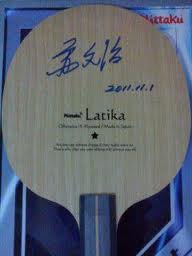
Joined: 09/26/2008 Location: Malaysia Status: Offline Points: 1144 |
 Post Options Post Options
 Thanks(0) Thanks(0)
 Quote Quote  Reply Reply
 Posted: 06/07/2009 at 3:17pm Posted: 06/07/2009 at 3:17pm |
|||||||||||||||||||||||||||||||||||||||||||||||||||||||||||||||||||||||||||||||||||||||||||||||||||||||||||||||||||||||||||||||||||||||||||||||||||||||
|
wow...
|
||||||||||||||||||||||||||||||||||||||||||||||||||||||||||||||||||||||||||||||||||||||||||||||||||||||||||||||||||||||||||||||||||||||||||||||||||||||||
 |
||||||||||||||||||||||||||||||||||||||||||||||||||||||||||||||||||||||||||||||||||||||||||||||||||||||||||||||||||||||||||||||||||||||||||||||||||||||||
figgie 
Gold Member 
Joined: 01/28/2005 Location: United States Status: Offline Points: 1026 |
 Post Options Post Options
 Thanks(0) Thanks(0)
 Quote Quote  Reply Reply
 Posted: 06/07/2009 at 4:03pm Posted: 06/07/2009 at 4:03pm |
|||||||||||||||||||||||||||||||||||||||||||||||||||||||||||||||||||||||||||||||||||||||||||||||||||||||||||||||||||||||||||||||||||||||||||||||||||||||
|
love physics and i understood everyone of your post JRDallas.
:)
FYI
I do 3d prototyping and might be able to do FEA for you based on the inputs your have provided rendered in 3d space of course. I am a rookie at it though so it will take some time but I like to try FEA on current stuff as it always is great to see what they came up with :)
Though I agree with you on the freq with speed. I myself tend to stick with lower freq blades (like Off- to All+ blades) as I have always liked the "feeling" they give. :)
Kudos for taking this on...
btw, check out wikipidea... it allows you to post equations which are pictures and then you can export them here. :)
|
||||||||||||||||||||||||||||||||||||||||||||||||||||||||||||||||||||||||||||||||||||||||||||||||||||||||||||||||||||||||||||||||||||||||||||||||||||||||
 |
||||||||||||||||||||||||||||||||||||||||||||||||||||||||||||||||||||||||||||||||||||||||||||||||||||||||||||||||||||||||||||||||||||||||||||||||||||||||
JRSDallas 
Silver Member 
Joined: 09/03/2005 Location: USA Status: Offline Points: 585 |
 Post Options Post Options
 Thanks(0) Thanks(0)
 Quote Quote  Reply Reply
 Posted: 06/07/2009 at 4:08pm Posted: 06/07/2009 at 4:08pm |
|||||||||||||||||||||||||||||||||||||||||||||||||||||||||||||||||||||||||||||||||||||||||||||||||||||||||||||||||||||||||||||||||||||||||||||||||||||||
|
I have the pictures but MyTableTennisl.net doesn't want to allow me to upload the pictures of the modes I've already modelled (via ANSYS).
If someone could explain how I can get sufficient permission to upload pictures that would be very helpful.
Thx
|
||||||||||||||||||||||||||||||||||||||||||||||||||||||||||||||||||||||||||||||||||||||||||||||||||||||||||||||||||||||||||||||||||||||||||||||||||||||||
 |
||||||||||||||||||||||||||||||||||||||||||||||||||||||||||||||||||||||||||||||||||||||||||||||||||||||||||||||||||||||||||||||||||||||||||||||||||||||||
infinite_loop 
Super Member 
Joined: 12/21/2007 Location: United States Status: Offline Points: 154 |
 Post Options Post Options
 Thanks(0) Thanks(0)
 Quote Quote  Reply Reply
 Posted: 06/07/2009 at 4:30pm Posted: 06/07/2009 at 4:30pm |
|||||||||||||||||||||||||||||||||||||||||||||||||||||||||||||||||||||||||||||||||||||||||||||||||||||||||||||||||||||||||||||||||||||||||||||||||||||||
Guys at the German TT forum tt-news.de have compiled a database of nearly 150 blade frequencies. If you don't have Excel/scalc, there is a Google cache copy of an older version here. This is what I understood from Google translation of this thread. I don't understand German, so, correct me if I am wrong. Their method of measuring blade frequencies is: - drop a TT ball from a fixed height onto the sweetspot of the blade to be tested - record the sound produced using your computer microphone - process the generated sound file using software to extract the frequencies - send the frequency data to the coordinating forum member who adds it to the database They are trying to calculate relative blade speed simply as a product of Frequency and mass. This is too simplistic to be accurate. But, according to them, this approximation agrees with how players feel about blade speed. |
||||||||||||||||||||||||||||||||||||||||||||||||||||||||||||||||||||||||||||||||||||||||||||||||||||||||||||||||||||||||||||||||||||||||||||||||||||||||
 |
||||||||||||||||||||||||||||||||||||||||||||||||||||||||||||||||||||||||||||||||||||||||||||||||||||||||||||||||||||||||||||||||||||||||||||||||||||||||
figgie 
Gold Member 
Joined: 01/28/2005 Location: United States Status: Offline Points: 1026 |
 Post Options Post Options
 Thanks(0) Thanks(0)
 Quote Quote  Reply Reply
 Posted: 06/07/2009 at 4:30pm Posted: 06/07/2009 at 4:30pm |
|||||||||||||||||||||||||||||||||||||||||||||||||||||||||||||||||||||||||||||||||||||||||||||||||||||||||||||||||||||||||||||||||||||||||||||||||||||||
|
JRDallas
i would not bother uploading here..
get an account in photobucket and upload them there
than here, add the following.
THis will link a picture from outside here. :)
|
||||||||||||||||||||||||||||||||||||||||||||||||||||||||||||||||||||||||||||||||||||||||||||||||||||||||||||||||||||||||||||||||||||||||||||||||||||||||
 |
||||||||||||||||||||||||||||||||||||||||||||||||||||||||||||||||||||||||||||||||||||||||||||||||||||||||||||||||||||||||||||||||||||||||||||||||||||||||
JRSDallas 
Silver Member 
Joined: 09/03/2005 Location: USA Status: Offline Points: 585 |
 Post Options Post Options
 Thanks(0) Thanks(0)
 Quote Quote  Reply Reply
 Posted: 06/07/2009 at 9:14pm Posted: 06/07/2009 at 9:14pm |
|||||||||||||||||||||||||||||||||||||||||||||||||||||||||||||||||||||||||||||||||||||||||||||||||||||||||||||||||||||||||||||||||||||||||||||||||||||||
|
My method of recording the frequencies of the various blades was initially the same as is being used on the German Forum. I too am dropping the ball onto the blade and recording the sound using a microphone. I then can identify the frequencies by doing a Fast Fourier Transform of each bounce. I also can see from the relative amplitude of the frequencies of where I've bounced the ball on the blade. For example, I can absolutely see more energy getting pumped into the 1st twisting if the bounce lands off of the center line of the blade.
I looked at the German data and my result for the Stiga Hybrid Wood is almost identical to the German value reported for it. As a result, I know this blade (and probably all of the others) were being held by hand at the time with no fingers touching the flat of the blade. I also know that the frequencies reported on the German Forum represent values for 4th out-of-plane bending mode.
The mode frequencies for a bare Stiga HybridWood being held in this way should likely fall somewhere along the lines of these:
Mode Frequency
1st bending 95 Hz
1st twisting 170 Hz
2nd bending 590 Hz
3rd bending 1130 Hz
4th bending 1330 Hz
I have to say should because I only borrowed the Hybrid Wood to make a brief similar measurement. I estimated the other frequencies based on more extensive measurements of other blades with similar 4th mode frequency. It won't be exact because the spacing between the frequency modes is also a function of a blades construction.
An interesting thing to know is that your hand absorbs the lower frequencies modes so that the microphone can't hear them. These lower frequency modes are the ones you feel when you hit with the blade.
As for their approach of paying attention to frequency and mass, yes these are the dominant variables but you are right in that other aspects also affect the feel.
One of these is the size of the face of the blade and its general geometry as this drives the second moment of area and the resonant length of the blade face. Most blades from a given brand have similar face sizes so comparing between these blades can tell you more about the relative material performance of the construction.
Another part of feel is related to the spacing between the various mode frequencies which can vary as the modulus of elasticity of the various blades is not always isotropic. In addition, there may be greater frequency dependence of the modulus of elasticity for some blades than for others.
When blades do not have uniform modulus (at a given frequency), they typically have higher modulus (greater stiffness) along the direction from handle to tip and from side-to-side.
I've also been interested in getting a fuller model of these secondary effects but I am more interested in the effect of the weight of the rubber, its modulus and frequency as a coupled system. I'm not there yet but I'll get there.
|
||||||||||||||||||||||||||||||||||||||||||||||||||||||||||||||||||||||||||||||||||||||||||||||||||||||||||||||||||||||||||||||||||||||||||||||||||||||||
 |
||||||||||||||||||||||||||||||||||||||||||||||||||||||||||||||||||||||||||||||||||||||||||||||||||||||||||||||||||||||||||||||||||||||||||||||||||||||||
JRSDallas 
Silver Member 
Joined: 09/03/2005 Location: USA Status: Offline Points: 585 |
 Post Options Post Options
 Thanks(0) Thanks(0)
 Quote Quote  Reply Reply
 Posted: 06/09/2009 at 12:30am Posted: 06/09/2009 at 12:30am |
|||||||||||||||||||||||||||||||||||||||||||||||||||||||||||||||||||||||||||||||||||||||||||||||||||||||||||||||||||||||||||||||||||||||||||||||||||||||
|
Here are pictures I was able to generate of the vibration mode shapes of a table tennis blade using Finite Element Analysis modeling. When playing your hand absorbs (and thus feels) the 1st bending, 1st twisting, 2nd bending, 3rd bending and 4th bending. The 1st in-plane bending may get excited by loop drive strokes but my testing by dropping a ball onto the blade does not cause this mode to vibrate strongly enough for me to see it in the spectrum data.
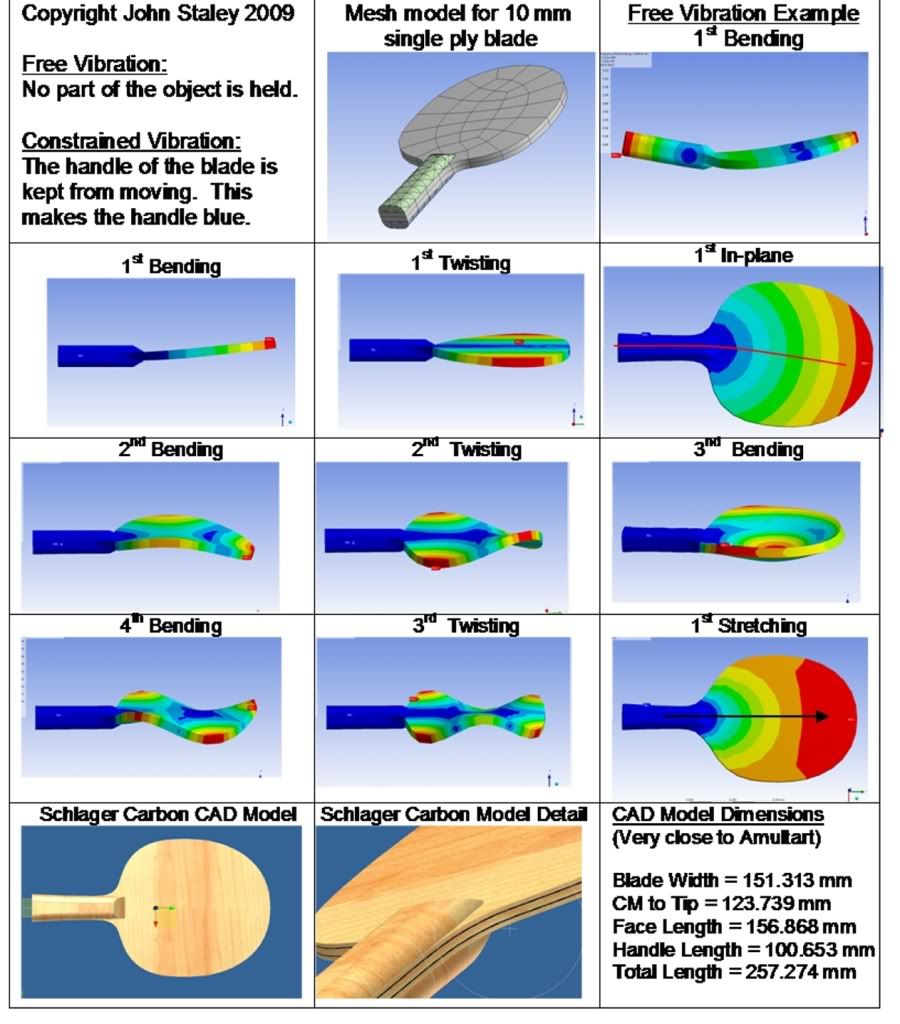 |
||||||||||||||||||||||||||||||||||||||||||||||||||||||||||||||||||||||||||||||||||||||||||||||||||||||||||||||||||||||||||||||||||||||||||||||||||||||||
 |
||||||||||||||||||||||||||||||||||||||||||||||||||||||||||||||||||||||||||||||||||||||||||||||||||||||||||||||||||||||||||||||||||||||||||||||||||||||||
JRSDallas 
Silver Member 
Joined: 09/03/2005 Location: USA Status: Offline Points: 585 |
 Post Options Post Options
 Thanks(0) Thanks(0)
 Quote Quote  Reply Reply
 Posted: 06/09/2009 at 1:12am Posted: 06/09/2009 at 1:12am |
|||||||||||||||||||||||||||||||||||||||||||||||||||||||||||||||||||||||||||||||||||||||||||||||||||||||||||||||||||||||||||||||||||||||||||||||||||||||
 |
||||||||||||||||||||||||||||||||||||||||||||||||||||||||||||||||||||||||||||||||||||||||||||||||||||||||||||||||||||||||||||||||||||||||||||||||||||||||
729 FX 
Silver Member 
Joined: 03/16/2009 Location: Malaysia Status: Offline Points: 619 |
 Post Options Post Options
 Thanks(0) Thanks(0)
 Quote Quote  Reply Reply
 Posted: 06/09/2009 at 3:36am Posted: 06/09/2009 at 3:36am |
|||||||||||||||||||||||||||||||||||||||||||||||||||||||||||||||||||||||||||||||||||||||||||||||||||||||||||||||||||||||||||||||||||||||||||||||||||||||
|
Wow. JRSDallas,
Are you human
I am impressed with your findings.
BTW, am interested to know the following 2 blades in terms of speed (faster or slower) as compared with the Clipper :
1) Primorac Carbon (no. 2 in your list)
2) Yinhe W-1 (no. 17 in your list)
Thanks for the info. mate.
|
||||||||||||||||||||||||||||||||||||||||||||||||||||||||||||||||||||||||||||||||||||||||||||||||||||||||||||||||||||||||||||||||||||||||||||||||||||||||
 |
||||||||||||||||||||||||||||||||||||||||||||||||||||||||||||||||||||||||||||||||||||||||||||||||||||||||||||||||||||||||||||||||||||||||||||||||||||||||
JRSDallas 
Silver Member 
Joined: 09/03/2005 Location: USA Status: Offline Points: 585 |
 Post Options Post Options
 Thanks(0) Thanks(0)
 Quote Quote  Reply Reply
 Posted: 06/11/2009 at 8:48pm Posted: 06/11/2009 at 8:48pm |
|||||||||||||||||||||||||||||||||||||||||||||||||||||||||||||||||||||||||||||||||||||||||||||||||||||||||||||||||||||||||||||||||||||||||||||||||||||||
|
The Yinhe W1 is noticibly faster than the Clipper while the Primorac Carbon is far faster than the Clipper.
The W1 is a very nice blade and has more power than Clipper.
The PC has much better smash and loop drives well if your strokes are not relying on the flex in the blade to give you forgiveness on your ball impact when looping. The PC is much stiffer and offers far more power. The W1 forgives many sins.
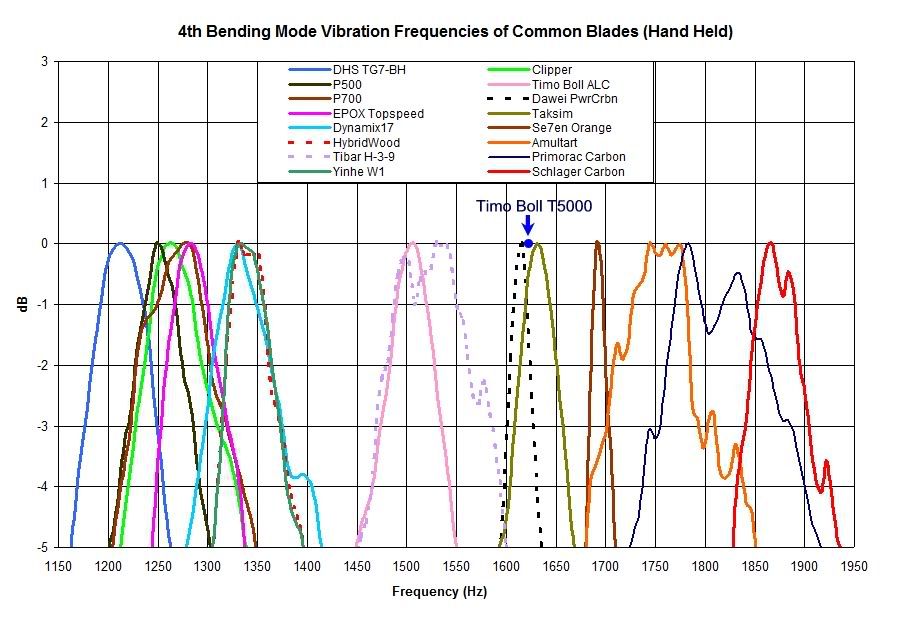 |
||||||||||||||||||||||||||||||||||||||||||||||||||||||||||||||||||||||||||||||||||||||||||||||||||||||||||||||||||||||||||||||||||||||||||||||||||||||||
 |
||||||||||||||||||||||||||||||||||||||||||||||||||||||||||||||||||||||||||||||||||||||||||||||||||||||||||||||||||||||||||||||||||||||||||||||||||||||||
729 FX 
Silver Member 
Joined: 03/16/2009 Location: Malaysia Status: Offline Points: 619 |
 Post Options Post Options
 Thanks(0) Thanks(0)
 Quote Quote  Reply Reply
 Posted: 06/12/2009 at 3:20am Posted: 06/12/2009 at 3:20am |
|||||||||||||||||||||||||||||||||||||||||||||||||||||||||||||||||||||||||||||||||||||||||||||||||||||||||||||||||||||||||||||||||||||||||||||||||||||||
|
Thanks for the information, JRSDallas.
|
||||||||||||||||||||||||||||||||||||||||||||||||||||||||||||||||||||||||||||||||||||||||||||||||||||||||||||||||||||||||||||||||||||||||||||||||||||||||
 |
||||||||||||||||||||||||||||||||||||||||||||||||||||||||||||||||||||||||||||||||||||||||||||||||||||||||||||||||||||||||||||||||||||||||||||||||||||||||
Sallom89 
Gold Member 

Joined: 05/19/2009 Location: Kuwait Status: Offline Points: 1925 |
 Post Options Post Options
 Thanks(0) Thanks(0)
 Quote Quote  Reply Reply
 Posted: 06/12/2009 at 4:43am Posted: 06/12/2009 at 4:43am |
|||||||||||||||||||||||||||||||||||||||||||||||||||||||||||||||||||||||||||||||||||||||||||||||||||||||||||||||||||||||||||||||||||||||||||||||||||||||
|
JRSDallas you are scary! nice stuff :O
Is Amultart CS any good in terms of speed and control? |
||||||||||||||||||||||||||||||||||||||||||||||||||||||||||||||||||||||||||||||||||||||||||||||||||||||||||||||||||||||||||||||||||||||||||||||||||||||||
|
Member of Wang Hao fan club.
Hurricane Hao III FH: Thors RPB: Omega Pro |
||||||||||||||||||||||||||||||||||||||||||||||||||||||||||||||||||||||||||||||||||||||||||||||||||||||||||||||||||||||||||||||||||||||||||||||||||||||||
 |
||||||||||||||||||||||||||||||||||||||||||||||||||||||||||||||||||||||||||||||||||||||||||||||||||||||||||||||||||||||||||||||||||||||||||||||||||||||||
Jeff(ATTC) 
Gold Member 
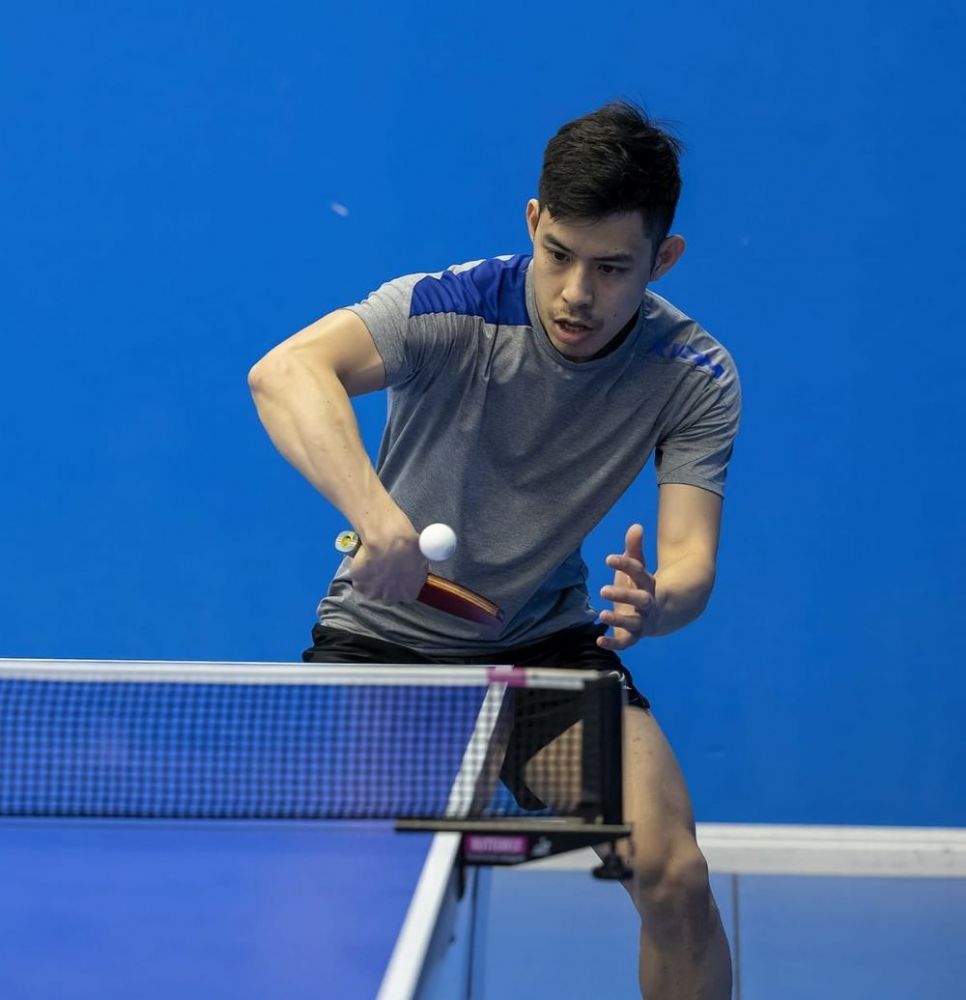
Joined: 09/22/2007 Location: United States Status: Offline Points: 1166 |
 Post Options Post Options
 Thanks(0) Thanks(0)
 Quote Quote  Reply Reply
 Posted: 06/12/2009 at 5:39pm Posted: 06/12/2009 at 5:39pm |
|||||||||||||||||||||||||||||||||||||||||||||||||||||||||||||||||||||||||||||||||||||||||||||||||||||||||||||||||||||||||||||||||||||||||||||||||||||||
|
Good work man! This is going to take a while for me to digest. Good work!
|
||||||||||||||||||||||||||||||||||||||||||||||||||||||||||||||||||||||||||||||||||||||||||||||||||||||||||||||||||||||||||||||||||||||||||||||||||||||||
|
Bty Jun Mizutani ZLC
FH: D80 BH: D05 |
||||||||||||||||||||||||||||||||||||||||||||||||||||||||||||||||||||||||||||||||||||||||||||||||||||||||||||||||||||||||||||||||||||||||||||||||||||||||
 |
||||||||||||||||||||||||||||||||||||||||||||||||||||||||||||||||||||||||||||||||||||||||||||||||||||||||||||||||||||||||||||||||||||||||||||||||||||||||
JRSDallas 
Silver Member 
Joined: 09/03/2005 Location: USA Status: Offline Points: 585 |
 Post Options Post Options
 Thanks(0) Thanks(0)
 Quote Quote  Reply Reply
 Posted: 06/12/2009 at 11:34pm Posted: 06/12/2009 at 11:34pm |
|||||||||||||||||||||||||||||||||||||||||||||||||||||||||||||||||||||||||||||||||||||||||||||||||||||||||||||||||||||||||||||||||||||||||||||||||||||||
|
The Amultart is a superb blade for speed and it offers just a touch of flex to give you feel and very strong spin with the speed. I think its very good on the FH for opening loops or loop driving or smashing. Its got a bit of a medium hard feel and it launches the ball. Throw is lower than a flexible blade.
As my BH loop is not as reliably dynamic, I have to be more careful when facing deep fast chop serves to my BH as I have less room for error. I suspect this is a stroke flaw more than a blade issue. Softer blades let me perform opening loops off such serves with greater success, but I end up being horribly limited on the FH and again limited on the BH at larger distances. I spin better but I end up being less of a threat overall.
|
||||||||||||||||||||||||||||||||||||||||||||||||||||||||||||||||||||||||||||||||||||||||||||||||||||||||||||||||||||||||||||||||||||||||||||||||||||||||
 |
||||||||||||||||||||||||||||||||||||||||||||||||||||||||||||||||||||||||||||||||||||||||||||||||||||||||||||||||||||||||||||||||||||||||||||||||||||||||
JRSDallas 
Silver Member 
Joined: 09/03/2005 Location: USA Status: Offline Points: 585 |
 Post Options Post Options
 Thanks(0) Thanks(0)
 Quote Quote  Reply Reply
 Posted: 06/16/2009 at 11:28pm Posted: 06/16/2009 at 11:28pm |
|||||||||||||||||||||||||||||||||||||||||||||||||||||||||||||||||||||||||||||||||||||||||||||||||||||||||||||||||||||||||||||||||||||||||||||||||||||||
|
I posted a graph showing some relative freqency peaks of various blades but here is a table of vibration frequencies for different vibration modes for a collection of OFF to OFF+ blades.
The listed frequencies are in Hz. The higher the 1st bending mode frequency, the faster the blade (in general) but the higher bending mode frequencies also have some impact on playing feel. Different examples of the same model blade will exhibit slisomewhat different frequencies because of their somewhat different mass and stiffness values within the individual wood veneers and carbon layers on that particular blade.
As an example I the 1st bending mode frequency for two Amultarts that I have are:
Amultart 89 gram = 127 Hz
Amultart 91 gram = 144 Hz (A noticably faster and more powerful blade)
However, even though the 144 Hz Amultart has a higher 1st bending mode frequency than even my Schager Carbon, the Schager is in fact a stiffer and faster blade. You can see this by looking at the frequency values of the higher vibration modes --> the Schlager 91gm mode 2, 3 and 4 frequencies are uniformly higher than the Amultart 91gm equivalent modes. Also the Schlager Carbon measures out at a higher stiffness.
Measured Stiffness:
TBT5K 89gm = 10.001 Nm2
Amultart 91gm = 15.790 Nm2
Schager Carbon 91gm = 16.006 Nm2
|
||||||||||||||||||||||||||||||||||||||||||||||||||||||||||||||||||||||||||||||||||||||||||||||||||||||||||||||||||||||||||||||||||||||||||||||||||||||||
 |
||||||||||||||||||||||||||||||||||||||||||||||||||||||||||||||||||||||||||||||||||||||||||||||||||||||||||||||||||||||||||||||||||||||||||||||||||||||||
7plywood 
Silver Member 
Joined: 03/07/2008 Location: United States Status: Offline Points: 683 |
 Post Options Post Options
 Thanks(0) Thanks(0)
 Quote Quote  Reply Reply
 Posted: 06/17/2009 at 12:24am Posted: 06/17/2009 at 12:24am |
|||||||||||||||||||||||||||||||||||||||||||||||||||||||||||||||||||||||||||||||||||||||||||||||||||||||||||||||||||||||||||||||||||||||||||||||||||||||
|
Nice read JRS. However if I read it correctly your experiment states that Timo Boll ALC (TBS basically) is slower than Balsa Carbo X5?
If so, I must say TBS feels much faster in real life.
|
||||||||||||||||||||||||||||||||||||||||||||||||||||||||||||||||||||||||||||||||||||||||||||||||||||||||||||||||||||||||||||||||||||||||||||||||||||||||
 |
||||||||||||||||||||||||||||||||||||||||||||||||||||||||||||||||||||||||||||||||||||||||||||||||||||||||||||||||||||||||||||||||||||||||||||||||||||||||
JRSDallas 
Silver Member 
Joined: 09/03/2005 Location: USA Status: Offline Points: 585 |
 Post Options Post Options
 Thanks(0) Thanks(0)
 Quote Quote  Reply Reply
 Posted: 06/17/2009 at 8:02am Posted: 06/17/2009 at 8:02am |
|||||||||||||||||||||||||||||||||||||||||||||||||||||||||||||||||||||||||||||||||||||||||||||||||||||||||||||||||||||||||||||||||||||||||||||||||||||||
|
Good observation and one which is matched by Butterflyonline values (which I find are really pretty good). My data is accurate but I believe that your observations and the butterflyonline values are probably also accurate so lets see if this can be resolved.
The BalsaCarbo I played with only briefly and it felt faster (but clearly less dynamic) than the TBALC that I own.
At the same time, the BalsaCarbo was significantly lighter and this effects hand speed (lighter --> faster swing speed up to a point), (lighter --> less power on impact at equal blade speeds). Also, the BalsaCarbo is not as dynamic a blade as the TBALC (you don't have the same flex envelope).
The speed difference is not large but at the higher frequency modes, the BalsaCarbo clearly remains stiffer than the TBALC. However, a somewhat heavier and stiffer TBALC could easily end up with frequencies higher than the example of the BalsaCarbo that I tested.
What is certainly true is that the TBALC blades are heavier than the BalsaCarbo and this will generally result in more "power" out of the TBALC and greater ball speed for players who's hand speed is not effected by the greater mass of the typical TBALC.
This deserves greater investigation but the data I have is what I have and I don't have the BalsaCarbo I measured.
|
||||||||||||||||||||||||||||||||||||||||||||||||||||||||||||||||||||||||||||||||||||||||||||||||||||||||||||||||||||||||||||||||||||||||||||||||||||||||
 |
||||||||||||||||||||||||||||||||||||||||||||||||||||||||||||||||||||||||||||||||||||||||||||||||||||||||||||||||||||||||||||||||||||||||||||||||||||||||
wyatt 
Super Member 
Joined: 01/25/2009 Location: Philippines Status: Offline Points: 403 |
 Post Options Post Options
 Thanks(0) Thanks(0)
 Quote Quote  Reply Reply
 Posted: 06/18/2009 at 10:02am Posted: 06/18/2009 at 10:02am |
|||||||||||||||||||||||||||||||||||||||||||||||||||||||||||||||||||||||||||||||||||||||||||||||||||||||||||||||||||||||||||||||||||||||||||||||||||||||
|
http://forums.oneofakindtrading.com.au/viewtopic.php?t=3673
|
||||||||||||||||||||||||||||||||||||||||||||||||||||||||||||||||||||||||||||||||||||||||||||||||||||||||||||||||||||||||||||||||||||||||||||||||||||||||
 |
||||||||||||||||||||||||||||||||||||||||||||||||||||||||||||||||||||||||||||||||||||||||||||||||||||||||||||||||||||||||||||||||||||||||||||||||||||||||
JRSDallas 
Silver Member 
Joined: 09/03/2005 Location: USA Status: Offline Points: 585 |
 Post Options Post Options
 Thanks(0) Thanks(0)
 Quote Quote  Reply Reply
 Posted: 06/18/2009 at 6:25pm Posted: 06/18/2009 at 6:25pm |
|||||||||||||||||||||||||||||||||||||||||||||||||||||||||||||||||||||||||||||||||||||||||||||||||||||||||||||||||||||||||||||||||||||||||||||||||||||||
|
The OOAK forum link points to a thread that lists various types of woods making up various blades.
You can calculate the "relative" performance between these blades if you know the thicknesses of each type of wood layer making up the blades being compared. You will also need to know the Modulus of Elasticity of each of type of wood.
I go into this in some detail on DTTW in the thread I referenced in the second post of this thread.
|
||||||||||||||||||||||||||||||||||||||||||||||||||||||||||||||||||||||||||||||||||||||||||||||||||||||||||||||||||||||||||||||||||||||||||||||||||||||||
 |
||||||||||||||||||||||||||||||||||||||||||||||||||||||||||||||||||||||||||||||||||||||||||||||||||||||||||||||||||||||||||||||||||||||||||||||||||||||||
HowToPlayChineseLoop 
Super Member 

Joined: 02/06/2012 Location: 0 Status: Offline Points: 266 |
 Post Options Post Options
 Thanks(0) Thanks(0)
 Quote Quote  Reply Reply
 Posted: 03/11/2012 at 9:07pm Posted: 03/11/2012 at 9:07pm |
|||||||||||||||||||||||||||||||||||||||||||||||||||||||||||||||||||||||||||||||||||||||||||||||||||||||||||||||||||||||||||||||||||||||||||||||||||||||
|
So the list of vibration frequency is a result of experimental result (ball dropped on the blade) or a result of FEA simulation ?
Because in your simulation model, you just used a single ply blade, right ? |
||||||||||||||||||||||||||||||||||||||||||||||||||||||||||||||||||||||||||||||||||||||||||||||||||||||||||||||||||||||||||||||||||||||||||||||||||||||||
 |
||||||||||||||||||||||||||||||||||||||||||||||||||||||||||||||||||||||||||||||||||||||||||||||||||||||||||||||||||||||||||||||||||||||||||||||||||||||||
jonyer1980 
Gold Member 
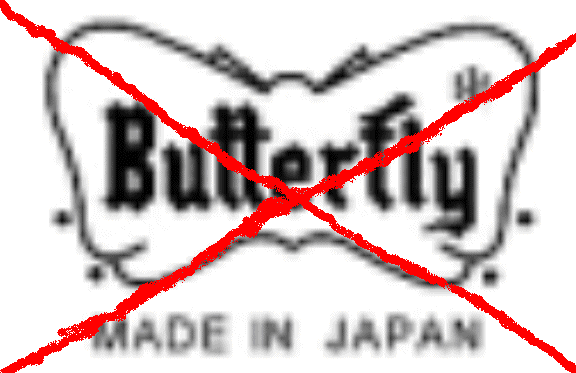
Joined: 07/30/2008 Location: Spain Status: Offline Points: 1600 |
 Post Options Post Options
 Thanks(0) Thanks(0)
 Quote Quote  Reply Reply
 Posted: 07/05/2018 at 3:00am Posted: 07/05/2018 at 3:00am |
|||||||||||||||||||||||||||||||||||||||||||||||||||||||||||||||||||||||||||||||||||||||||||||||||||||||||||||||||||||||||||||||||||||||||||||||||||||||
|
Was there a mobile app to measure it?
|
||||||||||||||||||||||||||||||||||||||||||||||||||||||||||||||||||||||||||||||||||||||||||||||||||||||||||||||||||||||||||||||||||||||||||||||||||||||||
|
Rosewood V FL
Nittaku Fastarc G1-FH Stiga DNA Pro-S MAX BH Avoid any Butterfly stuff... at abusive prices. Raw power without control means nothing |
||||||||||||||||||||||||||||||||||||||||||||||||||||||||||||||||||||||||||||||||||||||||||||||||||||||||||||||||||||||||||||||||||||||||||||||||||||||||
 |
||||||||||||||||||||||||||||||||||||||||||||||||||||||||||||||||||||||||||||||||||||||||||||||||||||||||||||||||||||||||||||||||||||||||||||||||||||||||
Post Reply 
|
|
|
Tweet
|
| Forum Jump | Forum Permissions  You cannot post new topics in this forum You cannot reply to topics in this forum You cannot delete your posts in this forum You cannot edit your posts in this forum You cannot create polls in this forum You cannot vote in polls in this forum |
|
Forum Home | Go to the Forums | Forum Help | Disclaimer
MyTableTennis.NET is the trading name of Alex Table Tennis Ltd. |